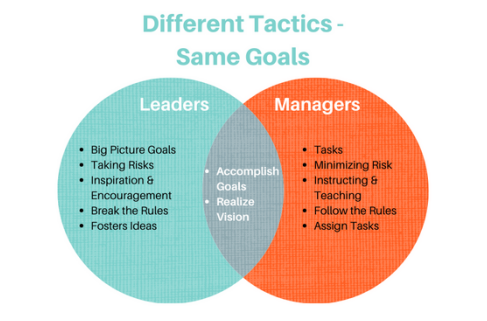Click here to download “5 Ways to Be a Better Leader” (PDF) or read it below.

How many times have you scrolled through your LinkedIn feed and come across memes like these? I’d wager conservatively that it happens at least once a day! The study of leadership is certainly an interesting and constantly evolving one.
If we look at what the “experts” above had to say, it’s clear that there is some disagreement on whether leadership can be taught. It’s a long-standing, ongoing, unresolved debate. However, the prevailing school of thought is that many leadership skills can be learned. There are endless coaches for CEOs, Sales, and Business, and you only have to Google “Leadership Certificate” to see that there is no lack of options to level up your game – including many Ivy League Institutions.
Introduction
I do a lot of reading about sales tactics, managing people, and even history – where I find many helpful and relatable lessons about business. I’ve been thinking a lot lately about some of the most underrated lessons about leadership. Whether you are the visionary, innovative leader who is revolutionizing an industry or a company founder, or even a manager who leads a team of people, I believe each of the five points I’m sharing today will help the efficacy of your business and hopefully your bottom line. However, better leadership ultimately leads to happier and more engaged workplaces and the people who work there. So even if fulfillment is the only thing you gain from working on these points, I believe your workplace will be better off.
I want to be clear about a few things before jumping in – when differentiating between leaders and managers, both are vital to a company’s success. Once you begin to dig deep into the subject matter experts on this topic, all too often, there tends to be a predisposition to make managers out to be the pencil-pushing bad character and leaders to be the pie-in-the-sky, altruistic doers. I firmly believe that just isn’t the case. Managers are just as necessary as visionary leaders for companies to thrive and are often on the front lines of leading people.
There are also two leadership topics that I’m not going to touch on. We are going to make some assumptions about leadership. Particularly that everyone understands empathy and authenticity are vital factors to being a good leader. There is excellent research-based work being done on these themes.
If you want to take a deeper dive, here are two interesting pieces to get you started.
Brené Brown – Taking off the armor and showing up authentically
Forbes Magazine – Empathy is the most important leadership skill according to research
Table of Contents
- Harness Your Innate Qualities
- Improve Your Self-Awareness
- Learn How to Lead Many Types of People
- Focus on What Leaders Focus on
- Embrace Ambiguity, Discomfort, & Change
Harness Your Innate Qualities
Let’s start by revisiting whether leadership can be taught or learned. When we look at lists of essential leadership skills, traits like communication, motivation, and responsibility pop up on nearly every index. You’d be hard-pressed to convince just about anyone that these skills can’t be taught.
On the other hand, skills like inspiring others, building relationships, and integrity verge into a greyer area when it comes to learned skills. These are more like qualities and characteristics – which isn’t to say that they aren’t skills that a person can work on, but I believe some are innate.
What can be taught is how specific traits are presented to others.
Wit is an excellent characteristic example. Someone can have a superb wit but at the same time can be introverted. We know that people are drawn to engaging, fun, and enjoyable leaders. Learning how to use that sense of wit appropriately and correctly in business environments can be highly beneficial.
Start by thinking about what you perceive to be your strengths, including tangible skills and characteristics. Are there any traits you feel you have that you struggle to utilize in the workplace? What strengths do you apply well outside of the office but haven’t figured out how to use in the business arena? It’s not unusual for people to focus on what they perceive to be their weaknesses. What if we focus on the pieces that we are really good at, working to make them great while identifying ways to bring our weaknesses into a tolerance band? You will never be a great leader allowing your strengths to be good and your weaknesses to be a distraction.
Identifying and exploiting innate qualities to benefit your business, employees, and clients helps you be a more genuine, comfortable, and confident leader.
Improve Your Self-Awareness
Growing up, there were several members of my family in the military. I excelled at math, and at an early age, I became very interested in becoming a pilot. However, I did not have eagle eye vision.
I also was not blessed in the height department, which led me to develop a bit of an aversion to basketball. I gravitated towards other sports, like soccer and baseball, where height wasn’t a defining factor for success. I learned early on that I could deny different aspects of my personality, but I couldn’t deny that I was short and my eyesight was not 20/20.
It became clear to me that I couldn’t overcome my vision problems. And just as I may have been too short for basketball, others didn’t have the hand-eye coordination needed to hit a baseball. Coming to terms with my height confines and vision limitations were important, early lessons that helped me focus on what I am good at and what I enjoy doing, and where the intersection of a fulfilling career could land me. Early on, I was fortunate to figure out the “do what you like and like what you do” mentality.
As people, who we are will sometimes weed us out of opportunities, and that’s okay. What is essential is to be realistic about our talents and skills and find ways to use those abilities to our best.
As kids are growing up, it’s not unusual that they get the message that they can be anything they want. On the one hand, this can help children understand the options available. On the other hand, it’s not entirely true. There are times when limitations will be beyond your control, but the saying still helps diminish limited thinking and encourages dreaming big.
According to the Harvard Business Review, “research suggests that when we see ourselves clearly, we are more confident and more creative. We make sounder decisions, build stronger relationships, and communicate more effectively. We’re less likely to lie, cheat, and steal. We are better workers who get more promotions. And we’re more-effective leaders with more-satisfied employees and more-profitable companies.”
Look at the important qualities mentioned: confidence, creativity, sound decision-making, relationship-building, communication, and ethical behavior. I feel strongly that self-awareness is a leadership skill that can be learned. It’s also a skill with excellent payoff because it informs many other aspects of your behavior.
If you are like me, it took a long time to come to terms with what I am good at and what is not my forte. I spent years trying to master some things naturally in conflict with my skill set. I also realized that even though I had strengths in some of these areas, they were things that I just didn’t want to do.
There are a few practices that you can implement to help you become more self-aware:

Ask for Feedback
First, you must select people you trust and know will be honest with you. Gathering their feedback will help you to understand how other people view you. Also, if you don’t currently have an anonymous 360-feedback process, this is another smart method to gather unvarnished feedback.
Imagine asking people you work with regularly, “What could I be doing to be a better leader?” You will undoubtedly receive beneficial feedback, even if it is painful to accept at times.

Develop Written Plans and Priorities
Writing down what you want to achieve makes it easier to track your progress. The statistics don’t lie – people who set goals are, in general, more successful.
 Seek Out Learning Moments
Seek Out Learning Moments
Determining the settings you will actually learn and implement from is an important consideration, just as whom you will accept advice from. Interactions, whether large, like presenting at a conference or minor, as a weekly one-on-one with an employee, all offer you an opportunity to assess how specific interactions transpired. Were you happy with the exchange? The outcome? Were there ways to better handle a situation? Reflecting on interactions can help you pinpoint behaviors that you are comfortable with, and those that with change could be more productive.
Take Tests
There is no shortage of assessment tests you can take, such as Engram, DiSC, Myers-Briggs, and Strengths Finder are among the most popular and respected options. Sometimes the tests confirm what you already know or intuit; however, they nearly always provide at least a nugget of info that can shed light on your personality and skill set.
Gary Vaynerchuck also has some great advice on improving your self-awareness.
Learn How to Lead Many Different Types of People
We need visionary leaders. We need intelligent managers. We need engaged employees. However, leading everyone and every situation precisely the same is not effective leadership.
The military might just be the most remarkable example of an entity that understands and excels at how to lead different types of people. Based on the military’s process, from day one of basic training, you are assessed for your potential and categorized into possible roles based on your skills and characteristics. Leaders will naturally mature and grow out of the pack. Basic is meant to begin the process of identifying the leaders, the followers, and everyone in between. It is a very specific system of structure and processes to encourage the leaders to rise to the top naturally.
The number one lesson in learning to lead different types of people is to get to know the people you are leading. It’s simple but a step so many people avoid. However, when you understand the motivations of the people you are leading, you instill stronger morale and have a better environment for productivity.
Think about the different ways people learn. How often have you heard someone say, “I’m a visual learner – I need to see this done before I can do it myself.” Other people excel when they have a detailed manual that they can read and refer to. Just as people learn differently, they need to be led differently.
We need to stop expecting all employees to behave and produce the same. And even more so, we need to stop expecting everyone to put in the same level of intensity, work, and time that you do. When we respect our employees’ roles and understand their circumstances, we can manage them in ways that allow them to reach their full potential.
For example, you have a young employee eager to learn, keen to produce, and who wants to put in extra effort and time. Managing them to their expectations and potential is very different from leading a mid-career team member who places significant value on being out the door by 6:00 pm. Both of these employees have the potential to be highly valuable team members, but chasing the first one out the door at 6 pm to do something else or keeping the latter till 10:00 pm each night will not end well.
Understand what your employees care about, get to know the humans behind the roles, and engage accordingly.
Lastly, mentoring is an outstanding practice for a variety of reasons. I’ve never met a great leader who didn’t take the time to mentor people. Beyond the apparent transfer of knowledge and experiences, most leaders who mentor find that they are learning through the process. Understanding the skill sets, talents, concerns, and work styles of people emerging in our field is essential if you plan to effectively lead the influx of Millennial and Gen Z employees. Conversely, many Gen X and Boomer employees are learning to succeed with bosses who are younger than them.
Focus on What Leaders Focus on
Leaders often focus on different things than managers. However, this is an opportunity for managers to enhance their leadership capabilities – after all, managers lead people.
Leaders focus on things like vision, inspiration, priorities, and solutions, and there isn’t an item on that list that managers shouldn’t focus on as well. After all, the overall goals should be the same – meeting company targets and advancing the company’s vision.
Whether you lead a team of 60 or 6, you should build a vision for that team – let’s get everyone rowing in the same direction. Executive-level leaders generally provide the macro vision, while managers often work the day-to-day micro aspects. Both are designed to help employees do what they otherwise wouldn’t naturally do. Both should be inspiring people to step out and maximize their potential. Giving your employees a road map of expectations and tools to achieve goals is good leadership. Prioritizing the workload helps employees to plan their work in the most appropriate ways. Leading with a solution-based approach is also a very positive attribute. I have yet to meet a leader who doesn’t appreciate a manager who approaches them with a solution instead of just a problem. Creating this work environment and empowering your team to share in these approaches builds a fantastic corporate culture.

Embrace Ambiguity, Discomfort, & Change
This is probably the most challenging piece of advice to work on, on the list. However, this is also one of the biggest differentiators. In ambiguous, uncomfortable situations, leaders have the opportunity to truly separate themselves apart from the pack. How people handle change, substantial, transformative change, says everything.
Let’s think a bit about genuinely transformative change. A perfect example is Netflix. Just ten years ago, the company was essentially a service that mailed you DVDs. However, in 2013, Netflix CEO Reed Hastings set about changing the company’s entire focus. No longer would they be a modern Blockbuster; instead, they’d lead the way in creating innovative, sought-after content. Hastings brought the whole company along on the journey by releasing an 11-page memo detailing his vision.
On a level perhaps more relatable to us, we aren’t talking about implementing a new voicemail system. But maybe, we are talking about something to transform the sales process. For veterans and new employees alike, this can be very unsettling. However, a new sales process can dramatically change how a company seeks to grow.
The pandemic has been an excellent example of how companies faced ambiguity and discomfort. It’s also a great lesson to look at companies that managed to adapt and change their service delivery models. Some companies are still trying to muddle through the changes, while others have adapted their workplace culture to allow employees and productivity to thrive. The key for those who succeed? Great leadership.
When it comes to learning how to improve your reaction to ambiguous circumstances and change, there are a few tactics that you can work on:
 Make decisions quickly when you may not have all the information.
Make decisions quickly when you may not have all the information.
Sometimes, no matter how much research you do or how many recommendations you get, you just won’t have all the facts. You cannot guarantee that a particular product or service will work for you or your clients. These are the times when learning to trust your gut, combined with confidence in your experience, will have to be enough to take the bull by the horns. Frequently in these situations, speed matters. Too many times, leaders who wait for all the answers lose the initiative.
A great example of this is Chef José Andrés – a world renowned chef who has recently gained notice as the head of World Central Kitchen, a non-profit organization that goes to the most troubled spots in the world and works to feed people on the ground. Check out this story on CBS Sunday Morning to learn more.
 Accept failure – as long as you learn from your mistakes.
Accept failure – as long as you learn from your mistakes.
Is it a cliché to say something when it’s true? If so, here I go – Everyone makes mistakes, the differentiator is that good leaders learn from their mistakes, correct the problem, and move on.
 Get good at having difficult conversations.
Get good at having difficult conversations.
There’s a meme floating around lately about the topic of brutal honesty. The gist is, why does honesty have to be brutal or harsh? We should strive for empathy, not brutality. Even a difficult conversation held with compassion can still be challenging. That difficulty level can increase when you have worked to develop authentic relationships with the people you lead. I find that practicing the conversation in advance, and even role-playing, can be helpful. You can also write out a bit of a logic model, where you provide the rationale for the decision or issue you are communicating. Each can help to develop the confidence needed to have a challenging conversation.

Conclusion
What is particularly interesting about these five suggestions is how well they work together and build upon one another. For example, increased self-awareness becomes a tremendous asset when preparing for and delivering a difficult conversation.
It is important to note that not all leadership is transferable. For example, someone who is excellent at leading a highly effective group who is laid back and casual may find it very difficult to transition to leading another highly effective team that relies upon strict discipline and formality.
Could General Patton lead a successful surfboard company comprised of laid back surfer employees who understand the nuances of what makes their product successful? Would he even want to?
What is truly amazing is the number of excellent leaders who find themselves at the right spot, at the right time. I think there are many paths to good leadership and just as many qualities that, when combined, create a great leader.
It’s not like baking bread, where even a slight mismeasurement or miscalculation can result in a dense, unpleasant loaf. There isn’t a recipe, and there aren’t eight steps, and boom, you are a great leader. Transformative leaders are unique in society and are not a dime a dozen, and every one of them is comfortable with taking risks that others don’t find reasonable. However, every one of them works on developing their leadership skills.

